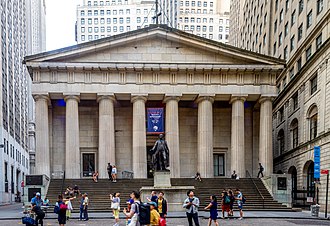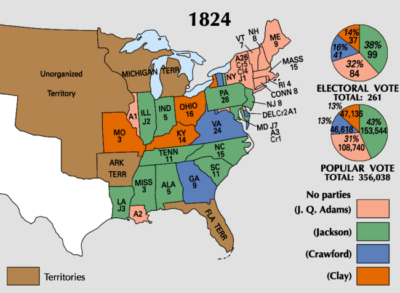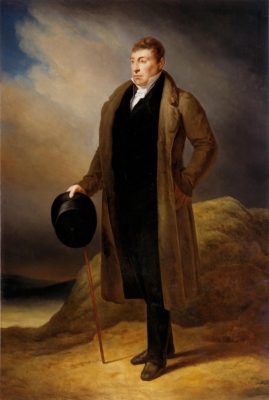
The Marquis de Lafayette is winding up the bicentennial of his tour of the United States as the nation’s guest by helping to naturalize 150 people from 43 countries at Federal Hall in New York in a ceremony conducted Chief Judge Laura Taylor Swain, United District Court for the Southern District of New York.
The ceremony combined history and civics at the historic site at the location where Washington once swore an oath of office and the fledgling country was governed. Naturally, the location being in southern New York City it was girded in scaffolding so the participants in the ceremony were forced to enter through the rear entrance rather than walk the step entrance with the statue of Washington. Still that was a short price to pay for what was about to unfold.
The proceedings represented a collaborative effort by multiple seemingly unrelated entities.
First, there was the American Friends of Lafayette (AFL) who provided Lafayette. He is nearing the end of his 13 month visit to the then United States. It began only months ago in New York when he first arrived in August and will conclude in September when he returns to France from Washington, DC.
Second, it was held Federal Hall instead of the usual Judge’s chambers. Historic Federal Hall is operated by the National Park Service which already has suffered from cutbacks, retirements, and layoffs. It will further be decimated by the passage of the new spending bill signed into law on July 4, 2025.
Third, it was conducted by the Southern District of New York. Normally the citizenship ceremony would have been held in the chambers of the Chief Judge. She agreed to relocate to Federal Hall.
Fourth, the music was provided by Tyler Diaz who played music composed by Charles Francis Johnson, University of Pennsylvania, in 1824 for Lafayette’s visit. This was an exceptional honor for a Black composer.
Fifth, this combination of entities was created by Abby Suckle, Vice President of the Lower Manhattan Historical Association (LMHA) as part of her “It happened here” initiative celebrating events which actually occurred in lower Manhattan.
Needless-to-say, the planning required to create this unique experience was tireless effort on Suckle’s part assisted by Catherine Hughes (LMHA).
The ceremony consisted of the following:
Jennifer Zehner, Park Ranger and Site Manager, National Park Service, welcomed people to this historic site.
Chuck Schwam, Executive Director, the American Friends of Lafayette, spoke about Lafayette’s importance in American history and the bicentennial celebration of visit in 1824-1825.
Lafayette himself, fully costumed, then addressed the future citizens, their families, and others in the audience about his love and hopes for this country. He passionately and robustly but briefly regaled the audience with his own experience as a one-time visitor to the country who helped bring about its creation in the American Revolution.
Chief Judge Laura Taylor Swain spoke about her own experience as the descendant of immigrants to New York. She was referring to the Great Migration from the former Confederacy north. Her very position as Chief Judge in the leading federal district in the United States spoke volumes about the opportunities for the soon-to-be-sworn in citizens. Besides her life story, she spoke about the importance of voting and joked about seeing the new citizens in her courtroom as jurors, another important responsibility as citizens. I don’t know what is customary for the remarks by a judge in a naturalization ceremony, so I have no basis for determining the length and subject of such comments. I suspect that being in Federal Hall with Lafayette may have influenced her to go beyond the routine to speak more historic than the usual “congratulation” comments.
Following her remarks, the future citizens where called up one by one to receive their certificate of citizenship. That action began a series of stops probably unique to this ceremony.
The new citizens then posed for pictures with Lafayette sometimes with a relative. It is quite possible that before the naturalization ceremony they had never heard of Lafayette before. Now they will have this photographic keepsake along with the naturalization certificate as a memory of the event.
They received a t-shirt “It Happened Here” from the cultureNow station.
They received information about Lafayette from the American Friends of Lafayette.
Finally they received a clipboard of voter registration forms to fill out.
As one might know or suspect, the naturalization ceremony was an emotional experience for the participants. People had waited years, even decades, before becoming citizens. Now the moment had arrived. The magical moment was an emotional experience for new-citizens there with their families. It was an emotional experience for others in the audience as well. It is easy to forget how meaningful becoming an American citizen can be, how important it is, and why people cry at these ceremonies.
We hear a lot these days about aspirations. We should consider the words of the Declaration of Independence and the Constitution as aspirations of a world we hope will come and not as one in which we live. That deflection into the future has its place in the American political discourse but it overlooks what is happening in the present.
Having been there at Federal Hall on July 3 for the naturalization ceremony, I can say
At that moment, in that place, in that ceremony, the words of aspiration were fulfilled;
At that moment, in that place, in that ceremony, the America Dream was lived;
At that moment, in that place, in that ceremony, we were a city on a hill.
There is only one word to describe what happened on July 3, 2025, naturalization ceremony at Federal Hall,
PERFECTION.








